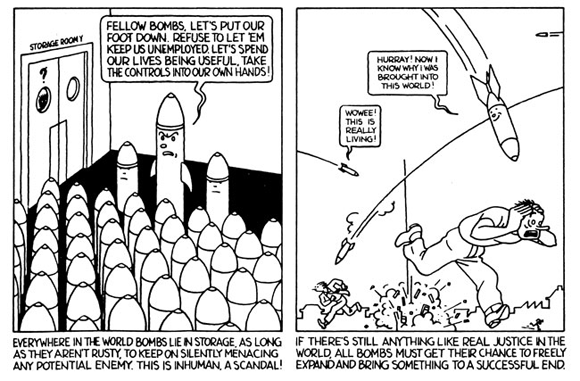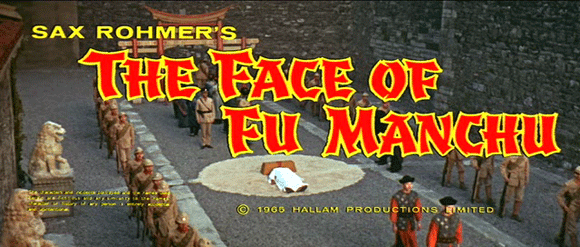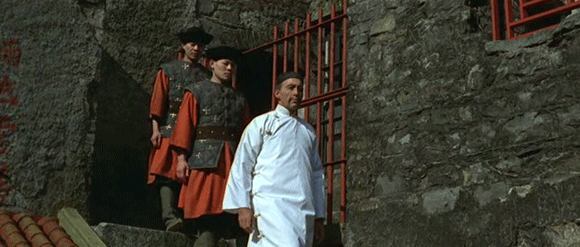
Martin Hunt invents great origami models depicting things out of the star wars universe and shows them off at ↑starwarigami. Unfortunately he withholds most of his diagrams as he wants to publish a book in which all of them are collected. But there are countless links to ↑diagrams by others at a subpage of starwarigami. If all those are too complex for you at the moment, try Chris Alexander’s simpler designs at ↑star wars origami. Chris already has published a book, hence at the moment, as far as I can see, ↑only the diagrams for his rendition of the Millenium Falcon is online. Ah, yes, just in case you think that I am a ↵complete n00b at this …
anthropology and cinema
early near futures
Many of the films discussed so far [films made from 1895 to 1910 and featuring science-fictional elements or qualities] could be said to be cinematic predictions of the future: from future warfare and advanced automatons to trips to the moon and visitors from another planet. Yet most of these narratives (or the film’s mise en scène more generally) suggested that events were taking place in an undefined present, the result of a recent technological breakthrough. This initial absence of futurity can also be found in much of the literature from which these early film narratives were drawing inspiration: Frankenstein, Twenty Thousand Leagues under the Sea, The First Men in the Moon, The War of the Wolds, and The Invisible Man were all based in present day (nineteenth century) settings. (Johnston 2011: 67—insertion in square brackets and bold emphasis’ mine)
In other words, they are set ↵20 minutes into the future …
la charcuterie mécanique
digital cybernator prophet
The infamous ↑Troma Entertainment, Inc. (‘almost 40 years of reel independence’) has uploaded a ton of full-length feature movies to ↑its YouTube channel. Among those are the glorious cyberpunkish b-pictures ‘↓Digital Prophet‘ (Romero 1996), ‘↓Cybernator‘ (Rundle 1991), and ‘↓New Gladiators‘ (Fulci 1984). But there’s also e.g. the horror classic ‘↓White Zombie‘ (Halperin 1932), starring Bela Lugosi. And much, much more …
joost swarte interview

↑The Comics Journal just republished online a ↑long interview which Daniel Peniston and Kim Thompson did in 2006 with Dutch comic book legend ↑Joost Swarte. The interview not only shows what a Renaissance man Swarte is, but there also are discussed e.g. architecture, theatre, and the Clear Line aka ligne claire, originally Klare lijn as coined by Swarte. A fine companion piece on the latter subject is Paul Gravett’s ↑Hergé & The Clear Line.
evolution of creationism
I sincerely urge everyone to read David Montgomery’s article ‘↓The evolution of creationism‘—it’s just about five pages long and absolutely concise and clear.
Abstract
For centuries, natural philosophers, their scientific successors, and theologians alike sought to explain the physical and natural world. The now common cultural narrative of perpetual conflict between science and religion simplifies the arguments and struggles of the past and overlooks cross-pollination between those who embraced faith and reason as the keys to understanding earth history. When geologists unequivocally dismissed the idea of a global flood and recognized Earth’s antiquity, many conservative theologians acknowledged that there was more to the past than literally spelled out in Genesis, the opening chapter of the Bible. But some Christians—those we now call creationists—rejected this perspective and chose to see geology as a threat to their faith. In so doing, they abandoned faith in reason and cast off a long-standing theological tradition that rocks don’t lie.
Here are some excerpts:
Buckland went on to admire the way in which originally horizontal strata were inclined such that mineral deposits and coal were accessible to miners, as well as how convenient it was that fertile soils were found in flat valley bottoms. Like many of his contemporaries, he thought geological evidence confirmed the Genesis stories and showed how well the world was designed for human use. (Montgomery 2012: 6)
How could strata have gotten flipped upside down after Noah’s Flood laid them down if the Bible did not mention subsequent catastrophes? Despite such qualms, fundamentalist proponents of flood geology were inclined to assess Price’s credibility by the conclusions he reached rather than the strength of his arguments or evidence. (Montgomery 2012: 7)
In their view, the plain meaning of God’s words trumped anything science could throw at it. “The instructed Christian knows that the evidences for full divine inspiration of Scripture are far weightier than the evidences for any fact of science” (Whitcomb and Morris, 1961, p. 118). (Montgomery 2012: 7)
Whitcomb and Morris simply dismissed fossil evidence for a long history of life “on the basis of overwhelming Biblical evidence” (1961, p. 457) and asserted that it was impossible to learn the age of the world through studying the operation of natural laws now in operation. The idea laughed out of Victorian England took root in Cold War America. (Montgomery 2012: 7)
While struggles over the geological implications of biblical interpretations date back to the earliest days of the Church, the story of how naturalists wrestled over reconciling the biblical flood with a growing body of contradictory geological evidence shows that the twentieth-century revival of flood geology recycled ideas previously abandoned in the face of compelling evidence. (Montgomery 2012: 8)
And yet, the geological case for a global flood that creationists offer as an alternative to evolution was discredited before Darwin set foot aboard The Beagle.
Geologists assess theories by how well they fit data, and creationists evaluate facts by how well they fit their theories. This simple distinction frames an unbridgeable intellectual rift. (Montgomery 2012: 8)How many creationists today know that modern creationism arose from abandoning faith that the study of nature would reveal God’s grand design for the world? (Montgomery 2012: 9)
the painted smile

The fifth of November it is, and indeed we do remember …
The next problem was the creation of the main character and the actual setting for the strip. Since ↑Dave [Lloyd] and I both wanted to do something that would be uniquely British rather than emulate the vast amount of American material on the market, the setting was obviously going to be England. Furthermore, since both Dave and myself share a similar brand of political pessimism, the future would be pretty grim, bleak and totalitarian thus giving us a convenient antagonist to play our hero off against. Not unnaturally, I recalled my original idea for “The Doll” and submitted a rough outline to Dave. It was a pretty conventional thing really and little more than predictable comic book fare with a few nice touches. It had the sort of grim, hi-tech world that you could seek in books like ↑Fahrenheit 451 or, more recently, in films like ↑Blade Runner. It had robots, uniformed riot police of the kneepads and helmets variety and all that other good stuff. Reading it, I think we both felt that we were onto something, but that sadly this wasn’t it. […]
One night, in desperation, I made a long list of concepts that I wanted to reflect in V, moving from one to another with rapid free-association that would make any good psychiatrist reach for the emergency cord. The list was something as follows; ↑Orwell. ↑Huxley. ↑Thomas Disch. ↑Judge Dredd. ↑Harlan Ellison‘s “‘Repent, Harlequin!’ Said the Ticktockman.” “Catman” and “Prowler in the City at the Edge of the World” by the same author. ↵Vincent Price‘s ↵Dr. Phibes and ↑Theatre Of Blood. David Bowie. ↑The Shadow. ↑Nightraven. Batman. Fahrenheit 451. The writings of the ↑New Worlds school of science-fiction. ↑Max Ernst‘s painting “↑Europe After The Rains,” ↑Thomas Pynchon, The atmosphere of British Second World War films. ↑The Prisoner. Robin Hood. ↑Dick Turpin…
There was some element in all of these that I could use, but try as I might I couldn’t come up with a coherent whole from such disjointed parts. I’m sure that it’s a feeling that all artists and writers are familiar with… the sensation of there being something incredibly good just beyond your fingertips. It’s frustrating and infuriating and you either fold up in despair or just carry on. Against my usual inclinations, I decided to just carry on. […]
The big breakthrough was all Dave’s, much as it sickens me to admit it. More remarkable still, it was all contained in one single letter that he’d dashed off the top of his head and which, like most of Dave’s handwriting, needed the equivalent of a Rosetta Stone to actually interpret. I transcribe the relevant portions beneath:
“Re. The script; While I was writing this, I had this idea about the hero, which is a bit redundant now we’ve got [can’t read the next bit] but nonetheless… I was thinking, why don’t we portray him as a resurrected ↵Guy Fawkes, complete with one of those papier mache masks in a cape and conical hat? He’d look really bizarre and it would give Guy Fawkes the image he’s deserved all these years. We shouldn’t burn the chap every Nov. 5th but celebrate his attempt to blow up Parliament!”
The moment I read these words, two things occurred to me. Firstly, Dave was obviously a lot less sane than I’d hitherto believed him to be, and secondly, this was the best idea I’d ever heard in my entire life. All of the various fragments in my head suddenly fell into place, united behind the single image of a Guy Fawkes mask. (Moore 1983—hyperlinks inserted by me)
who is emerging?
zeph’s pop culture quiz #48

Who is emerging from that door? And where is he headed to?
Just leave a comment with your educated guess—you can ask for additional hints, too. [Leaving a comment is easy; just click the ‘Leave a comment’ at the end of the post and fill in the form. If it’s the first time you post a comment, it will be held for moderation. But I am constantly checking, and once I’ve approved a comment, your next ones won’t be held, but published immediately by the system.]
UPDATE and solution (11 November 2011):

And again Alexander Rabitsch almost immediately ↵recognized the movie the screencap stems from: ‘↑The Face of Fu Manchu‘ (Sharp 1965), starring ↑Christopher Lee. But he is reluctant to tell us who it is, emerging from the doorway:

It’s Christopher Lee, yes, and within the story it seems that it is ↑Dr. Fu Manchu, heading towards his own beheading. Even his arch-enemy Sir Denis Nayland Smith (Nigel Green) believes so. But it isn’t. Rather the sinister Doctor has hypnotized an unnamed Chinese actor who now is executed instead. That’s not too much of a spoiler, because the ruse is quite obvious within the first few minutes of the movie.

flippy floppy sim

A well-known carrier over here once advertised the iPhone 4 as featuring a ‘new ↑SIM card technology.’ ↑What they meant was the so-called ‘micro-SIM.’ Well, meanwhile we have reached the ‘nano-SIM’—yet another unbelievable leap of technology. But hold your breath, it gets even better. By investing five bucks you can be at the forefront of innovation yourself, by buying the ‘Nano SIM Cutter,’ which ‘takes any regular or micro size and trims the excess off to provide you a precision cut nano SIM. It’s simple, you insert your SIM card with the contacts facing downwards, push the SIM card all the way in, and push down on the lever. The cutter will provide you with a perfectly cut nano SIM card every time! These Nano SIM Cutters are built from hi-quality stainless steel to ensure high precision cutting.’ [pictured on the left]
This reminded me of a technological triumph from back in the 1980s, from my time with a ↑C64. We used 5.25” ↑floppy disks (which indeed were floppy). Unfortunately you could only write data on one side of the disks—unless you cut a square whole into the disk cover at the right spot along its edge. Then you could simply flip the disk over, insert it into the drive, and read/write on the backside. This procedure made a floppy disk into a flippy disk. Some clever businessman professionalized the procedure and manufactured a precision floppy disk hole puncher [pictured on the right]—I even owned one of those.
Under the bottom line: micro-SIM to nano-SIM equals floppy disk to flippy disk.
Isn’t historical continuity in technology a wonderful thing?

